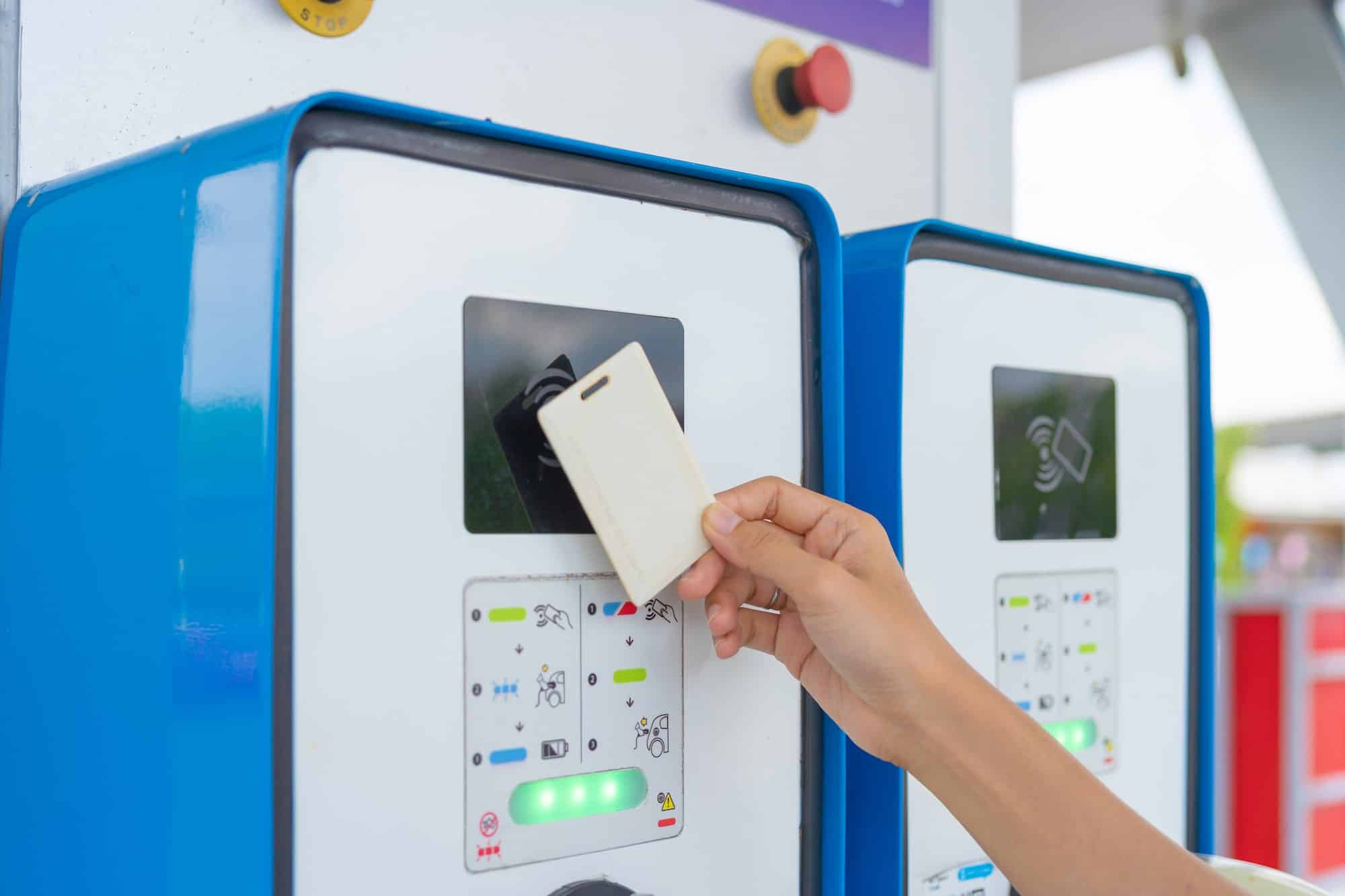Between government incentives and a push for environmental conservation, electric vehicles (EVs) are quickly becoming a more common sight on the road. While this purchase has a hefty price tag for buyers, installing EV chargers in your parking lot could ultimately be a lucrative endeavor.
If you currently own or operate a property with a public parking lot and are looking for a way to create more profits, keep reading to learn how to create a new recurring revenue stream by installing EV chargers.

What Are Electric Vehicle Chargers?
Unlike hybrid vehicles, which run on both gas and electric power, electric cars like the Tesla Model 3 are 100% battery-powered. So while EV owners may never need to worry about filling their gas tanks again, needing to find a charging station is an entirely different story.
Most EVs come with a compatible charger that can plug into a typical 120-volt AC outlet, but this method can take days to restore the battery to full power. Faster EV chargers are available for owners who want a quick power-up, but these typically have a higher price tag associated with them. However, in most larger cities, you can normally find them in retail areas like grocery stores, malls, public parking lots, and other locations.
How Much Does It Cost To Install EV Chargers?
The cost of installing an EV charger depends on a few factors, including the location and charger type. EV chargers have three levels with various features, costs, and voltages. Level 1 and Level 2 chargers are available for homeowners and commercial properties, but Level 3 chargers are only feasible in commercial settings.
Level 1
The Level 1 charger typically comes with the electric vehicle, so owners can recharge using a 120-volt outlet in their home. A charging station isn’t necessary for a Level 1 charger, but using one does help with a home’s energy efficiency. With an average power output of 1.3 to 2.4 kilowatts (kW), the Level 1 charging station can take more than 40 hours for a full charge.
The installation might cost between $1,000 to $1,700 for labor and $300 to $600 for the base station.
Level 2
Level 2 chargers are much faster but have a more complicated setup that increases the price. The charging station only works with a minimum 50-amp, 208 to 240-volt dedicated circuit. The installation requires complex electrical work, but the Level 2 station allows drivers to recharge their EV overnight fully.
A single-port Level 2 charging station costs between $500 to $700 per unit and $400 to $1,700 for labor. The dual-port station is considerably more expensive at $3,200 to $4,800 for one unit and $800 to $3,400 for labor.
Level 3
Considering the impressive charging power of Level 3 charging stations, it’s no wonder they could cost up to $20,000 for the unit and $50,000 for the installation. The Level 3 charger can top up a battery in approximately 30 minutes, allowing owners to quickly charge their vehicle while running errands. They require more power than most residential properties can handle, so you’ll typically find them only in commercial settings.
Electric Vehicle Charging Station Business Models
There are various approaches property owners can take when entering into monetizing their parking lot with EV charging stations. The business model you choose should mesh with your location or business and cover the operational costs to avoid losing money. Here, we review four business models you could use for monetization.
Loss Leader Model
In this model, you offer complimentary use of your EV charging station. The goal is to draw more customers to your business to boost brand awareness, customer loyalty, or just general foot traffic.
For example, let’s say an EV driver stops in your parking lot to quickly charge up their car before heading into work. Instead of sitting in his car for 10 minutes, he may head into the smoothie shop in the shopping center and spend some money at the business.
In this scenario, everyone wins. The EV driver is happy because he charged his car “for free,” the business owner is happy because she made a sale, and the landlord is happy because the business will stay open and continue to pay rent as well as future rent increases as their business improves. This added revenue more than makes up for the extra costs.
Cost Recovery Model
The cost recovery model involves charging a fee to drivers who want to use your charging station. Rather than making a profit, your price is just enough to cover the operational costs of the charging station. You might also add a service charge that could recover your installation expenses.
You’ll attract more drivers if the price is competitive compared to other local EV charging stations. This model aims to make the charging unit pay for itself, so the costs should be lower than those trying to make a profit.
Profit Making Model
This model is similar to the cost recovery plan but includes a higher fee to use the charging station. In this way, it pays for itself and provides you with a stream of income.
However, drivers might hesitate to use charging stations with these prices unless they have no choice. This business model might succeed less if other EV charging stations are available.
Fully Funded Model
You might have the option to have a third-party provider install a charging station on your property at no extra cost. You will benefit from attracting new customers and not having to pay operational expenses. The downside to the fully funded model is that the company that installs the station controls the price and charging experience.
How Much Can You Charge at an EV Charging Station?
The amount drivers pay at an EV charging station depends on several factors, including:
- The price set by the EV charging station provider
- The type of charger (Level 1, 2, or 3)
- The demand at a specific location, time, etc.
A Level 1 charger, which most drivers use at home, costs around $0.20 per kilowatt-hour (kWh) on average. The prices for public charging stations are generally higher because companies charge fees to cover operations and make a profit. Level 2 chargers could cost up to $0.25 per kilowatt-hour, while Level 3 fast chargers jump to $0.40 to $.060 per kWh.
How To Charge for EV Charging
The pricing strategy you choose for your EV charging station depends on your needs and goals. The two plans below show how EV charging providers can set prices for their units and potentially make an ongoing profit.
Subscriptions Plans and Service Packages
Subscription plans are a tried-and-true profit-earning model, and you can use them for your EV charging station. This option allows drivers to subscribe to a charging package, paying a monthly fee while enjoying the benefits you choose to offer them as loyal customers, such as a percentage off each charging session.
Time Frame and Charging Power Price Based
This pricing model attempts to prevent grid overload by charging different amounts at peak vs. off-peak charging times. The EV provider can use smart charging and billing software to adjust prices at certain times, so drivers pay more per kilowatt in peak hours and less during off-peak times.
Customer Billing Options
The three primary ways you can bill customers that use your EV chargers are pay-now, prepaid, and postpaid.
- Pay-Now: The driver pays for a single session at the charging station using their credit or debit card.
- Prepaid: The EV owners charge their vehicles using a prepaid account balance to which they can add money with a card or deposit.
- Postpaid: The bill for charging at your EV station gets sent to the driver each month per your agreement.
Benefits of Installing EV Chargers to Your Parking Area
The benefits you’ll reap by installing EV charging stations include and go beyond having additional revenue streams. We’ve outlined how adding EV chargers to your property can benefit you:
Increased Revenue Opportunities
Whether you offer EV charging for free or at a profit-making cost, they can bring in additional revenue for your business. Your charging stations will attract customers who might spend money at your business while waiting for their vehicle to charge. You can earn a profit if your fees are high enough and drivers have enough incentive to use your charging point.
Puts Your Business on the Map to Increase Customer Foot Traffic
EV owners use apps that inform them of EV charging locations. These apps allow them to plan their trips into town or across the country. You could significantly increase customer traffic if your business is on one of these maps and receives positive customer reviews.
Increases Your Property’s Value
As electric vehicles become more popular, businesses without EV charging infrastructure will struggle to keep up with those that do. By installing EV chargers in your parking lot, you’re adding value to your property that will become more evident in the future.
Available Tax Credits
The government has previously offered massive tax credits to EV charging station owners, and new EV credit guidelines are included in the 2022 Inflation Reduction Act. These tax incentives aren’t set to last forever, so installing EV chargers sooner rather than later is a sure way to benefit from these tax credits while they last.
Potential to Save on Electricity Bills
Certain charger manufacturers have added two-way power conversion capabilities to their charging stations. This feature allows EV chargers connected to your building’s energy system to be used as a reusable energy source, cutting down the costs of powering your business.
Schedule A Free EV Charger Viability Property Assessment In Florida Today!
If you think EV chargers may be a viable stream of business for your location, our team is happy to help you with the decision-making process. We will set up some time for a team member to come out and assess your parking lot for possible locations to place the EV chargers.
Once we’ve established the project scope, the installation is typically a very quick process. Our team will be in and out within a couple of days so that you can focus on the “boost” in your business! Contact us at 754-200-5872 or fill out a contact form, and one of our representatives will be glad to get you started!


